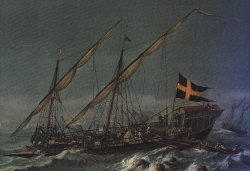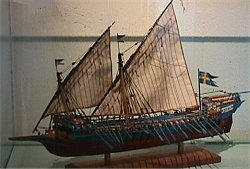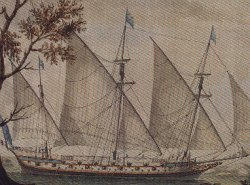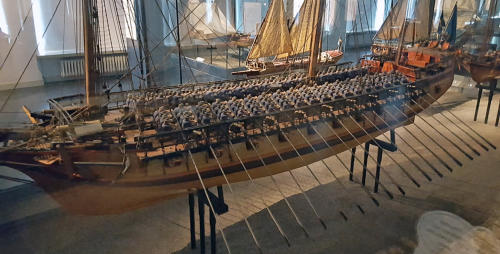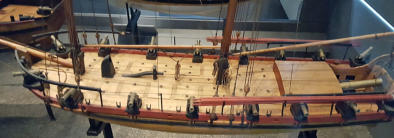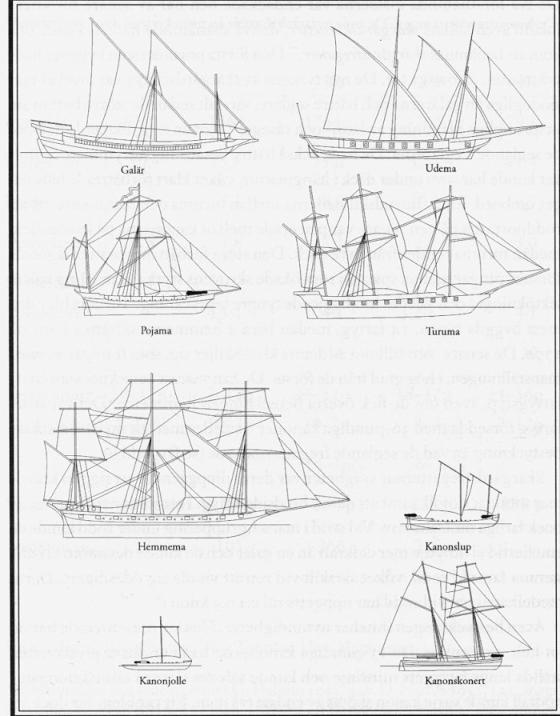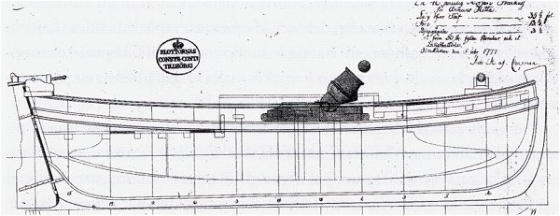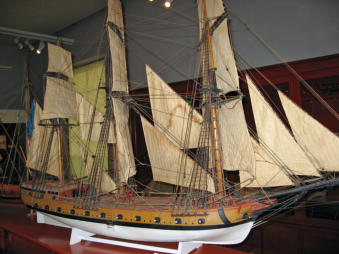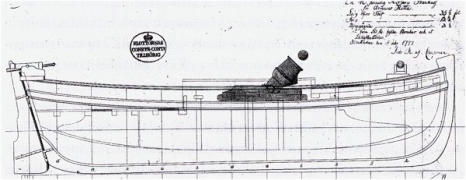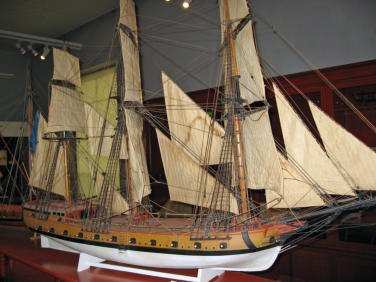

Copyright © Hans Högman 2017-06-16


The Army Fleet (Galley Fleet) of
Sweden in Former Days
Introduction
The Swedish Galley Fleet was organized after The
Great Nordic War, which ended in 1721.
At the end of this war the Swedish coastlines was
often under attack by Russian galleys. Galleys
turned out to be a perfect weapon in coastal
waters. The galleys could use both sails and oars,
which meant that they weren’t dependent on the
winds. They were shallow-draught (US: shallow-
draft) which made them perfect for warfare in
shallow coastal waters.
The Swedish and Finnish coastline are filled with
thousands and thousands of islands ans islets. I
most cases these waters between the islands are
narrow and very shallow. This type of coastline is
called archipelago (Swedish: Skärgård). The large
Navy warships were not suitable for warfare in
these narrow and shallow waters. Therefore
Sweden developed a second fleet, the Galley fleet.
Galleys couldn’t engage large navy ships in battles
on the open sea. However, with hardly any wind in
coastal waters galleys could attack a navy ship and
win the battle if they attacked from behind. The
navy ship was then like a sitting duck.
The big navy ships of the line were too big and had
a too deep draught to pursue the galleys into
shallow waters through the narrow channels of the
archipelago of Swedish waters.
The first type of vessel used by the Swedish Galley
fleet was of course the galley. That’s why the fleet
was called the Galley fleet (Galärflottan), at least in
the beginning.
Later, other more specialized ships were built for
the fleet. Galleys were just one type of ship used by
the Galley Fleet and later the galleys themselves
became out of date. So, the fleet therefore became
konwn as the Archipelago Fleet (Skärgårdsflottan)
later on.
The word “Skärgårdsflottan” means Archipelago Fleet
or the Coastal Fleet (Skärgård = archipelago).
The Galley Fleet becomes a branch within
the Army in 1756 - The Army Fleet
In the beginning the Galley Fleet was organized
as a unit within the Navy. In 1756 the Galley
Fleet was separated from the Navy and formed a
new defense branch within the Army. The
officers in the Galley Fleet thus carried the same
type of ranks as in the Army.
In 1823 the Galley Fleet once again became a part of
the Navy.
After 1756 the official name of the Galley Fleet
became The Army Fleet ("Arméns flotta").
In 1756 the Army Feet formed a fleet of about 60
vessels of different types.
The Army fleet was organized into two
squadrons, The Stockholm squadron
(Stockholmseskadern) and The Finish squadron
(Finska eskadern). Each squadron was under
command of a Colonel.
The home base for the Stockholm squadron was
Skeppsholmen in Stockholm and for the Finish
squadron, the Sveaborg fortress outside Helsinki.
[Finland was a part of Sweden until 1809).
Battles fought by the Army fleet had more similarities
with battles on land rather then the battles of the
navy. The purpose of the fleet was to co-operate
with land forces, protect the wings of the land
forces, transport the troops and support
offensive Army operations.
In 1786, just before the outbreak of the Swedish-
Russian war (1788-1790), the Stockholm squadron
numbered 31 larger vessels and the Finish
squadron 16 larger and 65 smaller vessels.
The years before the war the Army Fleet was
conducting a massive expansion and the numbers
increased a great deal. The master shipbuilder
Fredrik Henrik af Chapman (1721 - 1808)
constructed many new types of ships for the Army
fleet.
The crew on the ships of the Army Fleet
included both sailors and soldiers. The sailors
were under command of naval officers and the
soldiers under command of infantry officers.
The soldiers and the sailors were the "Knektar" and
"Båtsmän" respectively, organized by The Allotment
System (Indelningsverket).
The Allotment System was the system of organizing
and financing the Swedish armed forces in earlier
times.
The vessels of the Army fleet, never carried sails
during battle. They were either anchored or were
powered by oars.
Types of ships used by the Army
fleet
The Galley (Galär)
The Swedish galleys carried two masts. The length
of these craft varied between 100 - 130 feet (30 - 39
m), 18 feet (5.4 m) wide and 6 feet (1.8 m) deep
draught. They only had one deck. The main mast
was placed in the middle of the galley and
measured 54 feet (16 m) high. The foremast was a
bit shorter at 50 feet (15 m).
On the after deck as well as in the foredeck there
was a superstructure. The superstructure on the
after deck was used as a cabin for the officers. The
superstructure on the foredeck was used for the
artillery batteries, like a forecastle.
There were no protected
quarters for the crew
onboard the galleys.
The image to the right
shows the galley
"Calmar".
The galleys were
equipped with 20 to 22 pairs of oars, and each oar
was manned by 5 men. The oars were 40 feet (12
m) long. With 5 men per oar the galleys needed a
large crew: about 250 sailors. In total there were
about 300 men on the galleys.
Normally a lieutenant was the commander of a
galley.
The speed of a galley has
been estimated to have
been about 1 – 1,5 knots
when powered by oars
and about 3 knots under
sail.
The armament of the galleys normally consisted of
two 18- or 24-pound guns. They could also be
equipped with one 24-pound gun and two 6-pound
guns. The guns could only be fired in directions
forward of the bow. This limitation made the galleys
vulnerable and after 1745 very few new galleys
were built.
Example of galleys: The Carlscrona (1749), The
Calmar and The Uppland (1748).
The Schebeck
The schebeck was a ship similar to the galley but
with much better sailing qualities. The hull was
longer and narrower. The schebeck could carry
more guns than the galleys and needed only 9 pair
of oars.
The Archipelago Frigate (Skärgårdsfregatt)
In order to get a more powerful Army Feet, the
archipelago frigates were developed around 1760.
The designer was the master shipbuilder Fredrik
Henrik af Chapman. The frigates had very good
sailing qualities and could carry heavier armament.
Like the navy ships they could fire broadsides. A
few different types of frigates were built. The
names of the different types (classes) are names of
Finnish provinces.
The Udema class:
The Udema had one deck and three masts, 14 pair
of oars and a crew of 126 sailors. They were armed
with ten 12-pound and two 3-pound guns. Size:
length 100 feet (30 m) and 5 feet (1,5 m) deep
draught.
Example of ships: The Torborg (1772) and The
Ingeborg (1776).
The Pojama class:
The Pojama had one deck and two masts, 14 pair
of oars (two men per oar) and a crew of 105 sailors.
They were armed with two 12-pound and sixteen 3-
pound guns. Size: length 79 feet (23.8 m), 18.3 feet
(5.5 m) width and 6 feet (1,8 m) deep draught.
Example of ships: The Fröja (1764), The Disa (1764)
and The Brynhilda (1776).
The Turuman class:
The Turuman had two decks and three masts, 16
pair of oars (two men per oar) and a crew of 266
sailors. They were armed with twenty-four 12-
pound and four 3-pound guns. Size: length 118 feet
(35.6 m), 29.6 feet (8.9 m) width and 10 feet (3 m)
deep draught.
Example of ships: The
Norden (The Nordic) from
1762, and The Lodbrok
(1771).
The image to the right
shows an archipelago
frigate of the Turuman
class.
The Hemmema class:
The Hemmema had two decks and three masts, 14
pair of oars (two men per oar) and a crew of 220
sailors. They were armed with eighteen 12-pound
and sixteen 3-pound guns. Size: length 109 feet
(32.7 m), 33.3 feet (10 m) width and 9 feet (2,7 m)
deep draught.
In 1790 a second generation of the Hemmemas
were being launched. These Hemmemas were
bigger and carried heavier armament.
They were 145 feet (43.4 m) long, 35.7 feet (10,7 m)
wide and 10 feet (3 m) deep draught. They had 20
pairs of oars. They were armed with twenty-four 36-
pound and two 12-pound guns.
Example of ships: The Oden (The Woden) from 1764,
The Styrbjörn, The Starkoster and The Hjalmar (all
1789/90).
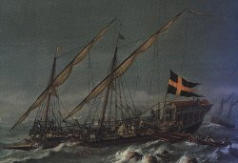
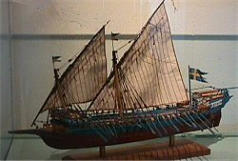
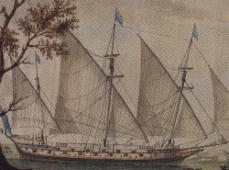
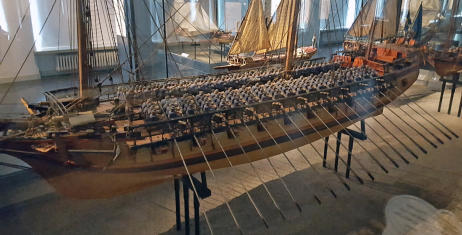
The Navy and the
Army Fleet of Sweden
in former days
Source References
1.
Det gotländska båtsmanshållet 1646 - 1887, Kjell
Olson, 1993
2.
Försvarets civilförvaltning 1634 - 1865, utgiven
1994 av försvarets civilförvaltning
3.
Svensksund, Gustaf III:s krig och
skärgårdsflottan 1788 - 1790 av Stig Jägerskiöld,
1990.
4.
Skärgårdsflottan, redaktör Hans Norman, 2000
Gunboats
A large number of smaller vessels with a heavy
armament were being built as well. There were two
types of these vessels, the gun sloop (kanonslupar)
and the gun tender (kanonjollar).
These gunboats could engage larger ships in artillary
duels. If circumstances tended to favor the gunboats
they would sometimes engage large navy ships.
A gunboat was a difficult target for larger ships
because they were very small and close to the
surface of the water. On the other hand, if a gun
boat was hit it had no protection.
The gun sloop (Kanonslup):
The gun sloop was equipped with sails and oars.
They had two masts, which were removable. They
carried 10 pairs of oars with two men per oar. They
were 52 feet (15.6 m) long and 13 feet (3.9 m) wide.
The gun sloop's draught was only 3 feet (0.9 m), so
they could operate in very shallow waters.
The gun sloops had a crew of 63 men. When being
powered by oars they could do 2.5 knots.
The gun sloops were normally armed with a 12-
pound gun, while some had an 18-pound gun. The
gun sloops could only fire the gun in the direction of
the bow.
Later they were equipped with two 24-pound guns.
One gun was placed on the stern and one on the
bow.
The gun sloops were kept together in their own
units. The gun sloop units were used both for attack
as well as for defensive purposes. They were also
used for reconnaissance.
During battles with the stationary tactics (when the
majority of the ships of the Army fleet was anchored
up) the role of the gun sloops were very similar to
the one of the cavalry in the army battles. That is a
mobile unit with a great power that could turn the
outcome of a battle into victory.
The first gun sloop was built in 1776. They came to
have a very conspicuous roll in the sea war of 1788 –
1790. In the spring of 1790 there were 127 gun
sloops in the Army fleet.
The Swedish gun sloops came to be a model for gun
sloops in many other nation's navies.
The gun tender (Kanonjolle):
The gun tender was introduced in the Army fleet in
1786. In a very short time 80 gun tenders was built.
The gun tender could best be described as a floating
gun carriage with a heavy gun.
The gun tender was very shallow-draught, only 2.5
feet (75 cm) and carried a crew of only 24 men. The
length of the tender was between 37 and 51 feet (11
m - 15 m) and had 5 – 10 pairs of oars. The tender
could also sail. Its armament was an 18 or a 24-
pound gun. It could only fire in the direction of the
stern.
Mortar longboats (Mörsarbarkass)
The Mortar longboats had an armament of a 40-
pound mortar. This type of vessel was used to
bombard targets on shore or enemy ships in the
shelter of islands. The mortar
longboat was 33 feet (10 m) long
and carried 7 pairs of oars.
The image shows a model of a
mortar longboat
(mörsarbarkass).
Photo Hans Högman, 2017.
Sjöhistoriska Museet (The
Maritime Museum), Stockholm.
Gun longboats (Kanonbarkass)
The gun longboats were rigged like a schooner and
had a length of 42 feet (12.6 m). Their draughts were
4 feet (1,2 m). They carried 8 pairs of oars so the
vessel could sail or use the oars. The armament of
gun longboats was a 12-pound gun.
A schooner is a sailing ship rigged with fore-and-aft
sails on its two or more masts.
The image shows a model of a gun longboat
(kanonbarkass). This is a replica of a longboat bulit in
the 1770s.
Photo Hans Högman, 2017. Sjöhistoriska Museet
(The Maritime Museum), Stockholm.
Gun Barge (Skottpråm)
The ”Skottpråm” (Gun barge?) was a broadside ship.
It carried three masts; the foremast 61.7 feet (18,5
m), main mast 68 feet (20,5 m) and the spanker 56.7
feet (17 m). It was equipped with 7 pair of oars
placed between the gun ports.
The gun barge were built in different sizes but a
common size was 127 feet (38 m) long and 33 feet
(9,9 m) wide. The draught was 9 feet (2,7 m). The
armament was twenty-four 12-pound and sixteen 4-
pound guns. It also carried two guns in the cabin
that could fire alongside if the ship was boarded by
the enemy. The cabin was built round the mizzen.
A normal crew was 250 men. The "skottpråm" did not
carry a figurehead, that is no extension in front of
the bow.
Example of gun sloops is The Kämpen (The Warrior)
from 1744 and The Hector.
The Hector carried a crew of 100 sailors and 300
infantry soldiers in 1751.
Drawings of the different types of
ships in the Army Fleet
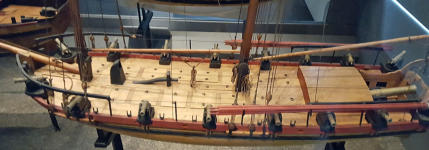
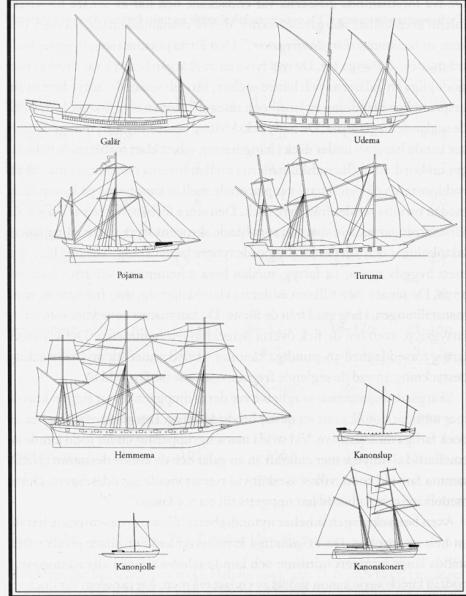
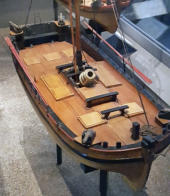
The image shows The Lodbrok, an archipelago
frigate of the Turuman class.
Photo Hans Högman, 2017. Sjöhistoriska Museet
(The Maritime Museum), Stockholm.
Mortar longboat (Mörsarbarkass)
Dictionary
•
Swedish
English
•
Galär
Galley
•
Udema, Pojama,
Turuma and Hemmena
Different classes of archipelago frigates
•
Kanonslup
Gun sloop
•
Kanonjolle
Gun tender
•
Kanonskonert
Gun schooner
•
Mörsarbarkass
Mortar longboat
The image shows The Styrbjörn, an archipelago
frigate of the Hemmema class.
Photo Hans Högman, 2007. Marinmuseum,
Karlskrona.







